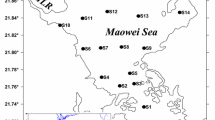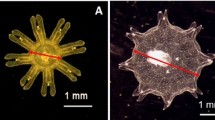Abstract
Standing stocks of ciliate plankton and its prey candidates, both picoplankton and nanoplankton, were investigated in spring in the East China Sea. The former was 1.36 × 105–1.54 × 108 μm3 l−1 in biovolume, and the latter was 5.33 × 106–1.11 × 108 μm3 l−1. The biovolume ratio of ciliate plankton to prey candidates ranged from 1.31 × 10−2 to 2.00 × 100; it was larger in abundant prey conditions and smaller in sparse preys. Making some plausible assumptions about physiological activity on both organisms, every ratio meet the quantitative restriction that prey production should be equal to or larger than ciliate consumption. However, prey candidates would be so sparsely distributed that ciliate plankton could not capture sufficient prey organisms in its random filter-feeding manner. Even though planktonic ciliates must have some extraordinary mechanisms to capture preys efficiently, this quantitative imbalance might be one of the reasons for decreasing ciliate/prey ratio in sparse prey conditions.







Similar content being viewed by others
References
Banse, K., 1982. Cell volumes, maximal growth rates of unicellular algae and ciliates, and the role of ciliates in the marine pelagial. Limnology and Oceanography 27: 1059–1071.
Bernard, C. & F. Rassoulzadegan, 1990. Bacteria or microflagellates as a major food source for marine ciliates: possible implications for the microzooplankton. Marine Ecology Progress Series 64: 147–155.
Burkill, P. H., 1982. Ciliates and other microplankton components of a nearshore food-web: standing stocks and production processes. Annales de L’Institut Océanographique 58: 335–350.
Capriulo, G. M. & E. J. Carpenter, 1980. Grazing by 35 to 202 μm microzooplankton in Long Island Sound. Marine Biology 56: 319–326.
Fenchel, T., 1987. Ecology of Protozoa. Springer Verlag, Berlin.
Fenchel, T., 1990. Adaptive significance of polymorphic life cycles in Protozoa: responses to starvation and refeeding in two species of marine ciliates. Journal of Experimental Marine Biology and Ecology 136: 159–177.
Fenchel, T. & B. J. Finlay, 1983. Respiration rates in heterotrophic free-living Protozoa. Microbial Ecology 9: 99–122.
Finlay, B. J., A. Span & C. Ochsenbein-Gattlen, 1983. Influence of physiological state on indices of respiration rate in Protozoa. Comparative Biochemistry and Physiology 74A: 211–219.
Gifford, D., 1985. Laboratory culture of marine planktonic oligotrichs (Ciliophora, Oligotrichida). Marine Ecology Progress Series 23: 257–267.
Jerome, C. A., D. J. S. Montagnes & F. J. R. Taylor, 1993. The effect of the quantitative protargol stain and Lugol’s and Bouin’s fixative on cell size: a more accurate estimate of ciliate species biomass. Journal of Eukaryotic Microbiology 40: 254–259.
Jonsson, P. R., 1987. Photosynthetic assimilation of inorganic carbon in marine oligotrich ciliates (Ciliophora, Oligotrichina). Marine Microbial Food Webs 2: 55–68.
Lindholm, T., 1985. Mesodinium rubrum—unique photosynthetic ciliate. Advance in Aquatic Microbiology 3: 1–48.
Lochte, K., 1991. Protozoa as Makers and Brakers of Marine Aggregates. In Reid, P. C., C. M. Turley & P. H. Burkill (eds), Protozoa and their Role in Marine Processes. Springer-Verlag, Berlin: 327–346.
Montagnes, D. J. S., 1996. Growth response of planktonic ciliates in the genera Strombidium and Storobilidium. Marine Ecology Progress Series 130: 241–254.
Montagnes, D. J. S. & D. H. Lynn, 1993. A Quantitative Protargol Stain (QPS) for Ciliates and Other Protists. In Kemp, P. F., B. F. Sherr, E. B. Sherr & J. J. Cole (eds), Handbook of Methods in Aquatic Microbial Ecology. Lewis Publishers, Boca Raton, 229–240.
Montagnes, D. J. S., D. H. Lynn, J. C. Roff & W. D. Taylor, 1988. The annual cycle of heterotrophic planktonic ciliates in the waters surrounding of Isle of Shoals, Gulf of Maine: an assessment of their trophic role. Marine Biology 99: 21–30.
Pierce, R. W. & J. T. Turner, 1992. Ecology of planktonic ciliates in marine food webs. Reviews in Aquatic Sciences 6: 139–181.
Putt, M., 1990. Metabolism of photosynthate in the chloroplast-retaining ciliate Laboea strobila. Marine Ecology Progress Series 60: 271–282.
Rassolzadegan, F., M. Laval-Peuto & R. W. Sheldon, 1988. Partitioning of the food ration of marine ciliates between pico- and nanoplankton. Hydrobiologia 159: 75–88.
Sheldon, R. W., P. Nival & F. Rassoulzadegan, 1986. An experimental investigation of a flagellate-ciliate-copepod food chain with some observations relevant to the linear biomass hypothesis. Limnology and Oceanography 31: 184–188.
Sherr, E. B., B. F. Sherr, R. D. Fallon & S. Y. Newell, 1986. Small aloricate ciliates as a major component of the marine heterotrophic nanoplankton. Limnology and Oceanography 31: 177–183.
Sherr, E. B., D. A. Caron & B. F. Sherr, 1993. Staining of Heterotrophic Protists for Visualization via Epifluorescence Microscopy. In Kemp, P. F., B. F. Sherr, E. B. Sherr & J. J. Cole (eds), Handbook of Methods in Aquatic Microbial Ecology. Lewis Publishers, Boca Raton, 213–227.
Sieburth, J., V. Smetacek & J. Lenz, 1978. Pelagic ecosystem structure: heterotorophic compartments of the plankton and their relationship to plankton size fractions. Limnology and Oceanography 23: 1256–1263.
Stoecker, D. K., D. Gifford & M. Putt, 1994. Preservation of marine planktonic ciliates: losses and cell shrinkage during fixation. Marine Ecology Progress Series 110: 293–299.
Stoecker, D. K. & M. W. Silver, 1990. Replacement and aging of chloroplasts in Strombidium capitatum (Ciliophora: Oligotrichida). Marine Biology 107: 491–502.
Stoecker, D. K., M. W. Silver, A. E. Michaels & L. H. Davis, 1988. Obligate mixotrophy in Laboea strobila, a ciliate which retains chloroplasts. Marine Biology 99: 415–423.
Stoecker, D. K., A. Taniguchi & A. E. Michaels, 1989. Abundance of autotrophic, mixotrophic and heterotrophic planktonic ciliates in shelf and slope waters. Marine Ecology Progress Series 50: 241–254.
Suzuki, T. & A. Taniguchi, 1993. Successional sequence of ciliates in surface water after a pulsed addition of deep water. Bulletin of Plankton Society of Japan 40: 27–39.
Taniguchi, A. & R. Kawakami, 1985. Feeding activity of a tintinnid ciliates Favella taraikaensis and its variability observed in laboratory cultures. Marine Microbial Food Webs 1: 17–34.
Verity, P. G., 1985. Grazing, respiration, excretion, and growth rates of tintinnids. Limnology and Oceanography 30: 1268–1282.
Verity, P. G., 1987. Abundance, community composition, size distribution, and production rates of tintinnids in Narragansett Bay, Rhode Island. Estuarine, Coastal and Shelf Science 24: 671–690.
Verity, P. G., 1988. Chemosensory behavior in marine planktonic ciliates. Bulletin of Marine Science 43: 772–782.
Acknowledgements
We acknowledge the captain, the officers and crew of the T/S Kakuyo-maru. We are grateful to Drs. J. Ishizaka and T. Matsuno for their help in collecting samples. This study is partly supported by a Grant-in-Aid for Scientific Research of Nagasaki University to T.S.
Author information
Authors and Affiliations
Corresponding author
Additional information
Handling editor: K. Martens
Rights and permissions
About this article
Cite this article
Suzuki, T., Miyabe, C. Ecological balance between ciliate plankton and its prey candidates, pico- and nanoplankton, in the East China Sea. Hydrobiologia 586, 403–410 (2007). https://doi.org/10.1007/s10750-007-0715-5
Received:
Revised:
Accepted:
Published:
Issue Date:
DOI: https://doi.org/10.1007/s10750-007-0715-5




